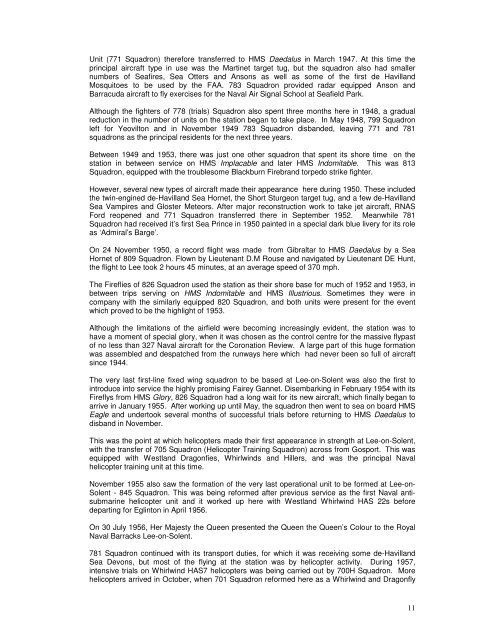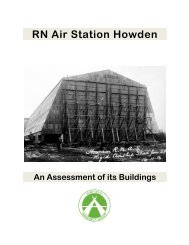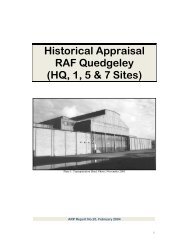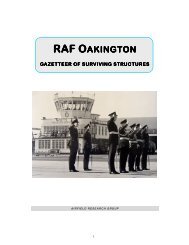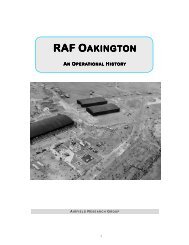RNAS Lee - The Airfield Research Group
RNAS Lee - The Airfield Research Group
RNAS Lee - The Airfield Research Group
You also want an ePaper? Increase the reach of your titles
YUMPU automatically turns print PDFs into web optimized ePapers that Google loves.
Unit (771 Squadron) therefore transferred to HMS Daedalus in March 1947. At this time the<br />
principal aircraft type in use was the Martinet target tug, but the squadron also had smaller<br />
numbers of Seafires, Sea Otters and Ansons as well as some of the first de Havilland<br />
Mosquitoes to be used by the FAA. 783 Squadron provided radar equipped Anson and<br />
Barracuda aircraft to fly exercises for the Naval Air Signal School at Seafield Park.<br />
Although the fighters of 778 (trials) Squadron also spent three months here in 1948, a gradual<br />
reduction in the number of units on the station began to take place. In May 1948, 799 Squadron<br />
left for Yeovilton and in November 1949 783 Squadron disbanded, leaving 771 and 781<br />
squadrons as the principal residents for the next three years.<br />
Between 1949 and 1953, there was just one other squadron that spent its shore time on the<br />
station in between service on HMS Implacable and later HMS Indomitable. This was 813<br />
Squadron, equipped with the troublesome Blackburn Firebrand torpedo strike fighter.<br />
However, several new types of aircraft made their appearance here during 1950. <strong>The</strong>se included<br />
the twin-engined de-Havilland Sea Hornet, the Short Sturgeon target tug, and a few de-Havilland<br />
Sea Vampires and Gloster Meteors. After major reconstruction work to take jet aircraft, <strong>RNAS</strong><br />
Ford reopened and 771 Squadron transferred there in September 1952. Meanwhile 781<br />
Squadron had received it’s first Sea Prince in 1950 painted in a special dark blue livery for its role<br />
as ‘Admiral’s Barge’.<br />
On 24 November 1950, a record flight was made from Gibraltar to HMS Daedalus by a Sea<br />
Hornet of 809 Squadron. Flown by Lieutenant D.M Rouse and navigated by Lieutenant DE Hunt,<br />
the flight to <strong>Lee</strong> took 2 hours 45 minutes, at an average speed of 370 mph.<br />
<strong>The</strong> Fireflies of 826 Squadron used the station as their shore base for much of 1952 and 1953, in<br />
between trips serving on HMS Indomitable and HMS Illustrious. Sometimes they were in<br />
company with the similarly equipped 820 Squadron, and both units were present for the event<br />
which proved to be the highlight of 1953.<br />
Although the limitations of the airfield were becoming increasingly evident, the station was to<br />
have a moment of special glory, when it was chosen as the control centre for the massive flypast<br />
of no less than 327 Naval aircraft for the Coronation Review. A large part of this huge formation<br />
was assembled and despatched from the runways here which had never been so full of aircraft<br />
since 1944.<br />
<strong>The</strong> very last first-line fixed wing squadron to be based at <strong>Lee</strong>-on-Solent was also the first to<br />
introduce into service the highly promising Fairey Gannet. Disembarking in February 1954 with its<br />
Fireflys from HMS Glory, 826 Squadron had a long wait for its new aircraft, which finally began to<br />
arrive in January 1955. After working up until May, the squadron then went to sea on board HMS<br />
Eagle and undertook several months of successful trials before returning to HMS Daedalus to<br />
disband in November.<br />
This was the point at which helicopters made their first appearance in strength at <strong>Lee</strong>-on-Solent,<br />
with the transfer of 705 Squadron (Helicopter Training Squadron) across from Gosport. This was<br />
equipped with Westland Dragonfies, Whirlwinds and Hillers, and was the principal Naval<br />
helicopter training unit at this time.<br />
November 1955 also saw the formation of the very last operational unit to be formed at <strong>Lee</strong>-on-<br />
Solent - 845 Squadron. This was being reformed after previous service as the first Naval antisubmarine<br />
helicopter unit and it worked up here with Westland Whirlwind HAS 22s before<br />
departing for Eglinton in April 1956.<br />
On 30 July 1956, Her Majesty the Queen presented the Queen the Queen’s Colour to the Royal<br />
Naval Barracks <strong>Lee</strong>-on-Solent.<br />
781 Squadron continued with its transport duties, for which it was receiving some de-Havilland<br />
Sea Devons, but most of the flying at the station was by helicopter activity. During 1957,<br />
intensive trials on Whirlwind HAS7 helicopters was being carried out by 700H Squadron. More<br />
helicopters arrived in October, when 701 Squadron reformed here as a Whirlwind and Dragonfly<br />
11


